Food vocabulary in any language is probably the most fun and also most challenging to learn because there are just so many words to get to grips with.
Although some food words share the same Chinese, most of the time this can actually make learning new words easier because you simply add an extra character to create a whole new vegetable.
For example, 萝卜 (luó bo) is radish, whilst 红萝卜 (hóng luó bo) with the addition of 红 meaning red will get you a ‘red radish’.
Additionally, vegetables and fruits from the same ‘family’ may also share a similar character, such as 南瓜 (nán guā) ‘pumpkin’, 黄瓜 (huáng guā) ‘cucumber’ and 冬瓜 (dōng guā) ‘squash’ which all contain the character 瓜 (guā) meaning ‘melon or gourd’.
Below are some short vocabulary lists to start you off learning some food, drink and household items that you can buy in the supermarket, as well as some useful phrases you might need when shopping.
Special Offers in Chinese
Special offers in the supermarket will usually be highlighted at the end of an aisle or with a colourful tag. Even if your Chinese characters aren’t perfect yet, keep an eye out for the following to make sure you don’t miss out on some great deals!
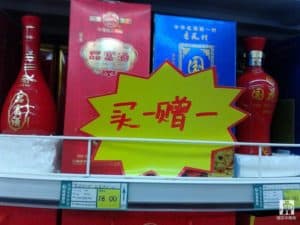
买一送一 (mǎi yī sòng yī) Buy one get one free (lit. buy one give one)
Percentage discounts in China do not show the amount of discount you will receive, but the percentage you will actually pay.
A sign promoting 8折 is not promoting an 80% discount, but a 20% discount. The 8折 means you will pay 80% of the original price.
…折 (…zhé) % discount
…元两件 (…yuán liǎng jiàn) Buy two for ##RMB
Useful Phrases for the Supermarket
请问…在哪儿? (qǐng wèn…zài nǎr?) Where is the ….?
请问这个多少钱? (qǐng wèn zhè ge duō shao qián) How much is this?
请问…还有吗? (qǐng wèn…hái yǒu ma?) Are there anymore?
可以帮我切一下吗? (kě yǐ bāng wǒ qiē yī xià ma?) Can you cut it for me?
可以帮我称一下这个吗? (kě yǐ bāng wǒ chēng yī xià ma?) Can you weigh this please?
重量 (zhòng liàng) Weights
(公)克 (gōng kè) gram
斤 (jīn) 500g
公斤 (gōng jīn) 1kg
Food and Drink Vocabulary
饮料 (yǐn liào) Drinks
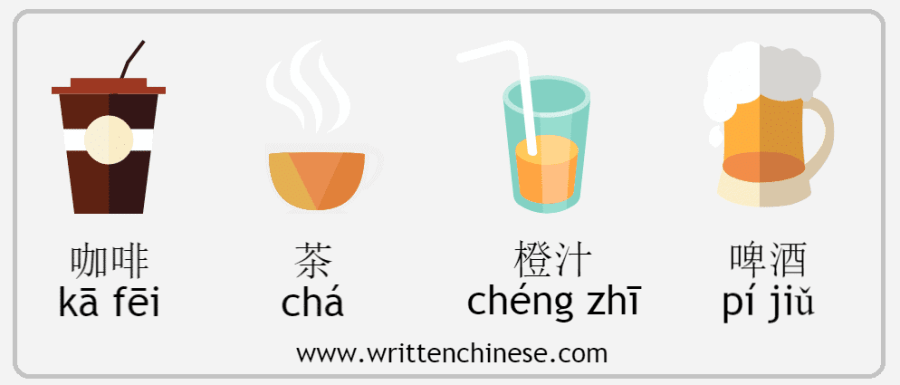
茶 (chá) tea
咖啡 (kā fēi) coffee
橙汁 (chéng zhī) Orange juice
啤酒 (pí jiǔ) Beer
乳制品 (rǔ zhì pǐn) Dairy
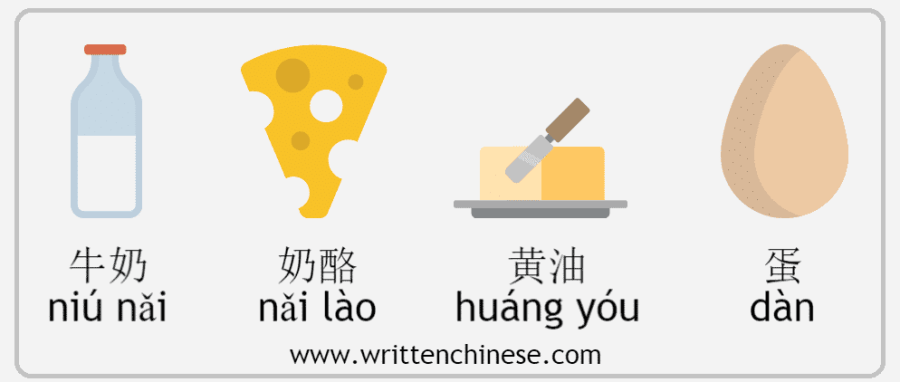
牛奶 (niú nǎi) milk
酸奶 (suān nǎi) yoghurt
黄油 (huáng yóu) butter
奶酪 (nǎi lào) cheese
The borrowed word 芝士 (zhī shì) is also frequently used for the word ‘cheese’.
蛋 (dàn) eggs
In China, there are many different kinds of eggs available to buy in the supermarket. The general word for egg in Chinese is 蛋 (dàn), but to specifically ask for ‘chicken eggs’ you must say 鸡蛋 (jī dàn).
蔬菜 (shū cài) Vegetables

土豆 (tǔ dòu) Potato
胡萝卜 (hóng luó bo) Carrots
菠菜 (bō cài) Spinach
白菜 (bái cài) Cabbage
西兰花 (xī lán huā) Broccoli
花椰菜 (huā yē cài) Cauliflower
水果 (shuǐ guǒ) Fruit
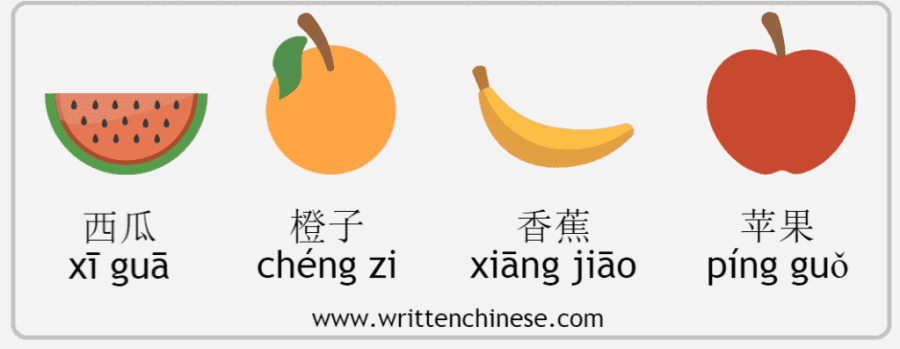
苹果 (píng guǒ) Apples
橙子 (chéng zi) Oranges
西瓜 (xī guā) Watermelon
柚子 (yòu zi) Pomelo
火龙果 (huǒ lóng guǒ) Dragon fruit
李子 (lǐ zi) Plums
香蕉 (xiāng jiāo) Bananas
柠檬 (níng méng) Lemons
梨子 (lí zi) Pears
调味料 (tiáo wèi liào) Spices and Condiments
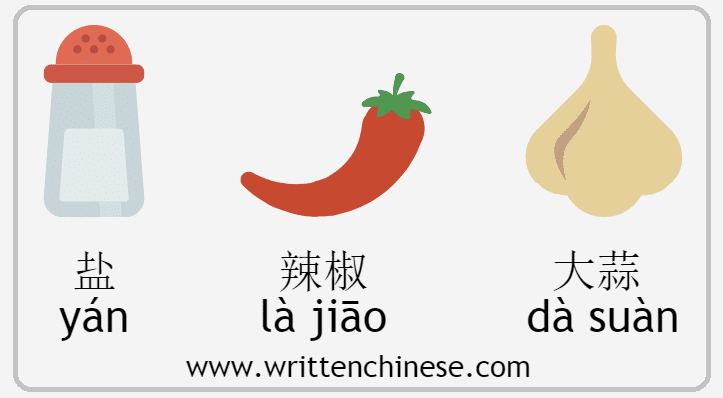
盐 (yán) Salt
大蒜 (dà suàn) Garlic
辣椒 (là jiāo) Chili
番茄酱 (fān qié jiàng) Tomato Sauce/Ketchup
花生酱 (huā shēng jiàng) Peanut Butter
酱油 (jiàng yóu) Soy Sauce
醋 (cù) Vinegar
烘焙,谷物 (hōng bèi, gǔ wù) Baked Goods, Cereals & Grains
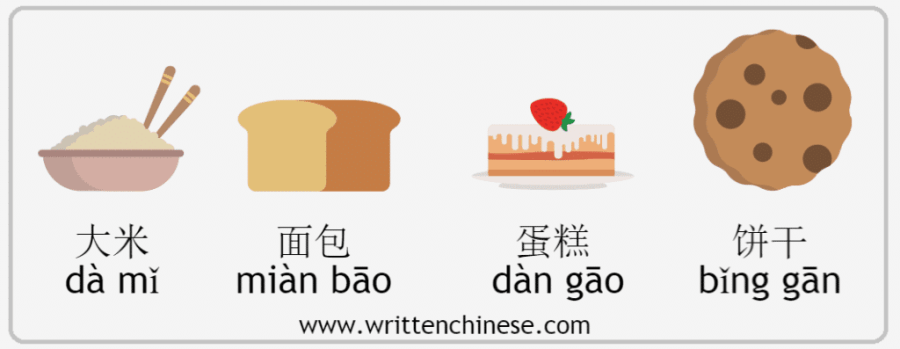
面包 (miàn bāo) Bread
蛋糕 (dàn gāo) Cake
饼干 (bǐng gān) Cookies
燕麦粥 (yàn mài zhōu) Porridge/Oatmeal
面条 (miàn tiáo) Noodles
大米 (dà mǐ) Rice
Uncooked rice has a different name to cooked rice in Chinese. So, if you wish to buy a bag of uncooked rice in the supermarket use the bigram 大米 (dà mǐ). You can ask for cooked rice in a restaurant with the bigram 米饭 (mǐ fàn).
鱼肉 (yú ròu) Meat & Fish
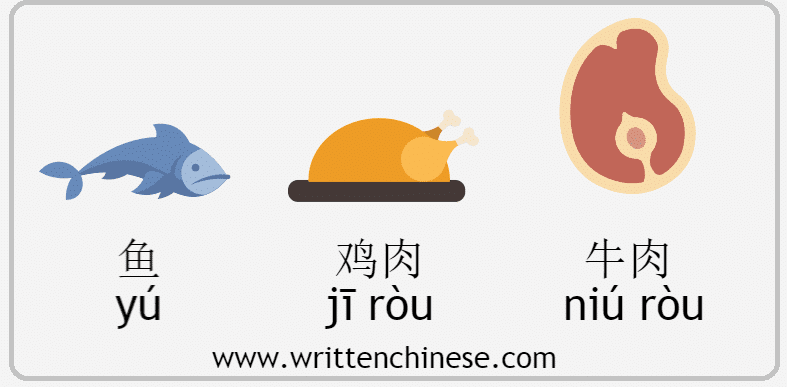
Although the character for ‘meat’ in Chinese is 肉 (ròu) if you see the character on a menu, or in the supermarket without another character such as 牛 (niú) ‘cow’ or 鸭 (yā) ‘duck’, then this probably means it is pork.
牛肉 (niú ròu) Beef
鸭肉 (yā ròu) Duck
鸡肉 (jī ròu) Chicken
鱼 (yú) Fish
日用品 (rì yòng pǐn) Household Goods
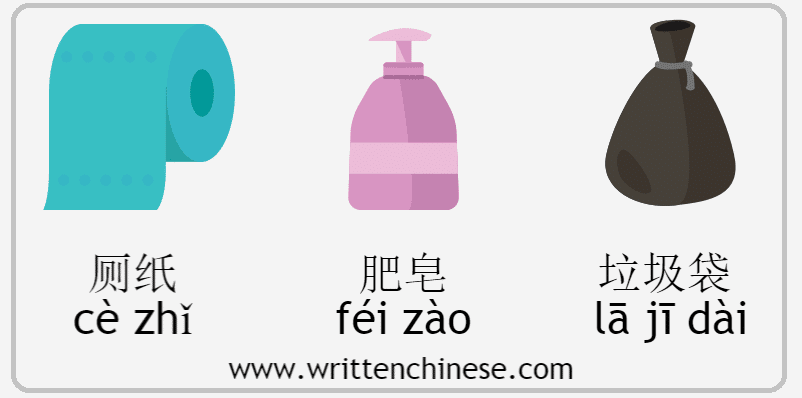
厕纸 (cè zhǐ) Toilet roll
肥皂 (féi zào) Soap
垃圾袋 (lā jī dài) Rubbish bags
擦碗布 (cā wǎn bù) Dish cloth
洗洁精 (xǐ jié jīng) Washing liquid
Other Vocabulary
有机 (yǒu jī) Organic
进口 (jìn kǒu) Imported
国产 (guó chǎn) Domestic
You can learn more more shopping dialogues in our article How to Order Coffee in Chinese and Other Dialogues You Need to Know
